By Michele Leggott and Catherine Field-Dodgson
14 January 1890
The Colonial Government Steamship Hinemoa reaches Campbell Island with botanists Thomas Kirk and Frederick Chapman on board. The steamer has visited the Snares and the Auckland Islands, travelling ever further south into the brief sub-antarctic summer since leaving Bluff 8 January on her periodic tour of the islands. The weather continues unusually fine and calm. Chapman wonders again at the size and beauty of the sub-antarctic mega-herbs that surround them:
In the part of the island where we now were, the plants, though not as numerous as at Adam’s Island, were even more beautiful. Here the Pleurophyllum speciosum was in better season, and the flowers were of a much deeper purple than those we had seen before. From being isolated the plants had grown better, and each was a picture in itself. […] One plant growing here, which was generally past flowering at Adam’s Island, is Pleurophyllum criniferum. The flowers are by no means so pretty as those of P. speciosum, but the general effect of the plant, with flower-bearing scapes 4ft. high, is very striking. Here, too, we found in flower the beautiful golden lily called Anthericum rossii. This was plentiful enough at the Auckland Islands, but generally past flowering. When in perfection it is a beautiful flower, and I find it easy to cultivate. (Transactions, Vol 23 1890: 513, 514)
That same day, 14 January 1890, Thomas Kirk collects specimens of purple-flowering Pleurophyllum speciosum, Anthericum rossii (golden lily) and red-flowering Ligusticum antipodum. The specimens go into the heavy boxes of plants destined for museums and gardens in Wellington and Dunedin, where Kirk and Chapman base their botanical and horticultural researches. In May Chapman will read his detailed and lively paper about the Hinemoa’s cruise before the Otago Institute. ‘The Outlying Islands south of New Zealand’ paints vivid panoramas of the remote islands, their seabirds and seals and their spectacular alpine environments.
14 October 1890
Thomas Kirk has been unwell. He is 62 and has not been able to attend the opening of Emily Harris’s exhibition of native flora at Baker Brothers Auction Mart on Lambton Quay in Wellington. But his wife Sarah is there and invites the artist to visit them at home in Brougham St, Mount Victoria. Emily writes in her diary:
I had tea yesterday with Mr & Mrs Kirk. Mr Kirk showed me a lot of lovely pressed flowers from Campbell Island & lent me some to copy, he is coming tomorrow to show me over the Botanical Gardens. […] I went again to the Kirks’, spent nearly all day sketching rare flowers in Mr Kirk’s study & from his garden. (17 Oct 1890)
The days spent sketching Campbell Island plants in Kirk’s study and garden lead to 13 sub-antarctic works across eight species, many of them large-format watercolours. One of these, now in the Turnbull Library, resurrects in vibrant colour some of the flowers Kirk and Chapman saw on their first day at Campbell Island. Two species are named, the third, a Pleurophyllum speciosum with dark blue centres and white ray florets, is unidentified in the faint pencilling at the bottom edge of the painting:

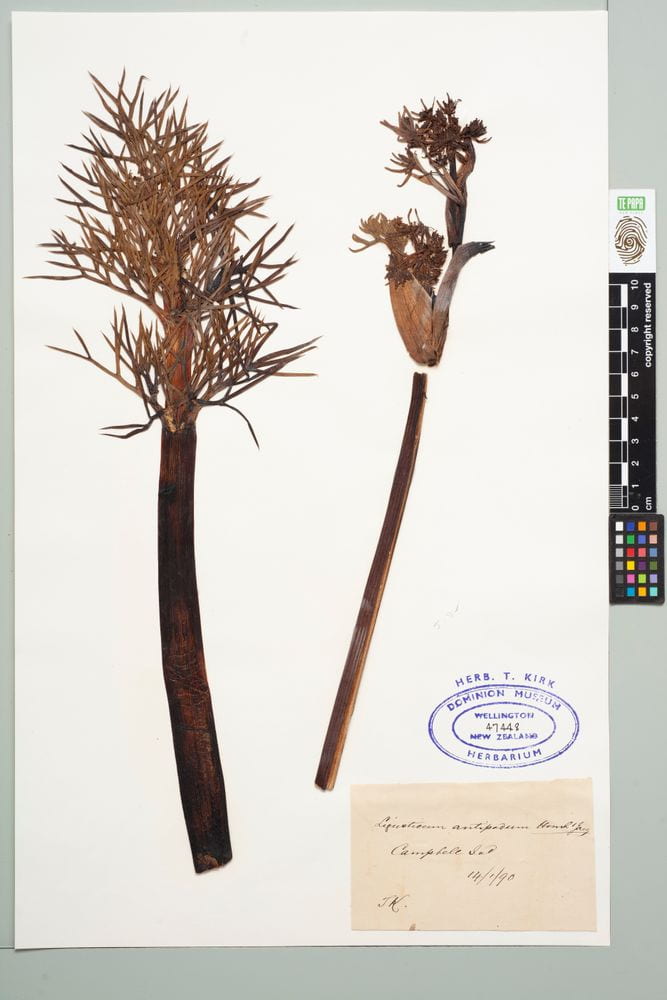
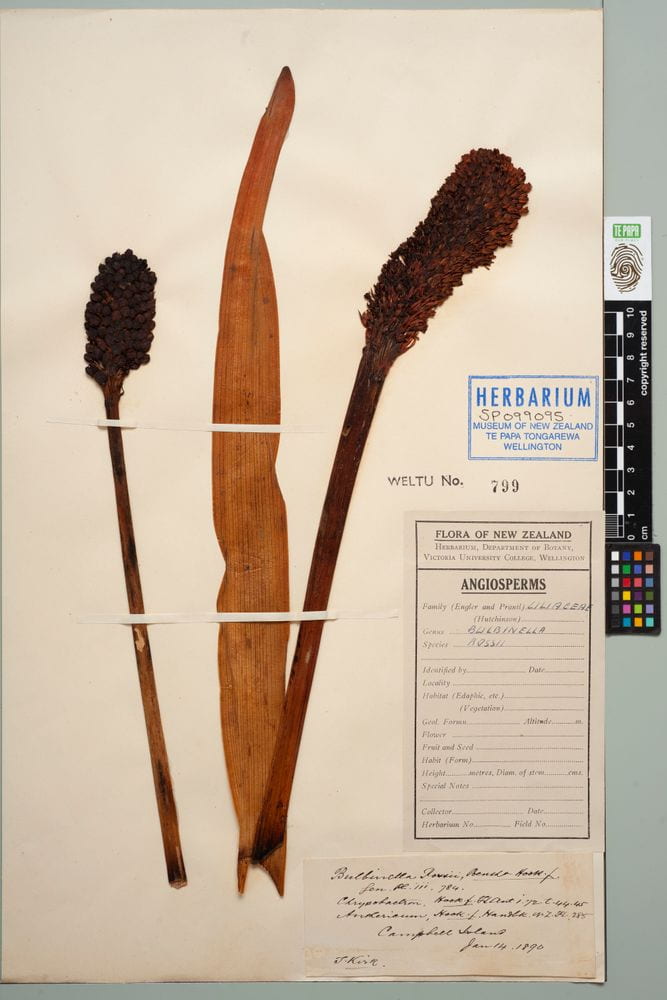
It is an exciting moment for Emily, being given access to botanical material that will extend the range of plants in her depictions of rare indigenous flora. It is an exciting moment for us, matching Emily’s paintings with Kirk’s botanical specimens preserved in the national collection. Art looks at science and reciprocates the scientist’s accuracy and eye for detail. It is in fact possible to map almost all of Emily Harris’s subantarctic works to source specimens in Kirk’s collection at Te Papa.
But there is more to say about Chapman and Kirk as they come to the hill above Venus Cove at Campbell Island on the afternoon of 14 January. This is the place where Sir Joseph Hooker collected botanical specimens on the Antarctic expedition of 1840 and where the French expedition of 1874 was unsuccessful in its attempt to observe the Transit of Venus.
14 January 1890 (redux)
Frederick Chapman has noted the tendency to giantism of even the smaller plants of Campbell Island’s northwest coast:
Here, too, the Celmisia vernicosa grew leaves less polished than at the Aucklands, but 5in. and 6in. long—i.e., usually twice as long as those we had gathered before. The flower-heads were numerous, from six to twelve on each plant, and were in full perfection. The figure in Hooker’s “Flora Antarctica” is an admirable representation of this plant. Their centres were of two colours—light and dark purple—but we attributed this to difference in degree of maturity. I brought back some of them, but have found them more difficult to preserve alive than the small plants from Adam’s Island. (Transactions, Vol 23 1890: 513)
Hinemoa continues her sweep of the island’s coasts, checking for signs of wreckage or castaways who might be subsisting on stores left at the depot on her previous visit.
In the afternoon we again went round the west coast and entered Perseverance Harbour, which is a very fine sheet of water, with straight shores. There are several good anchorages. Mount Honey, the highest hill on the island, is on one side, and Lyall Pyramid on the other. The ridges on either side are 800ft. high. […] Landing near Venus Cove we were soon among beautiful and interesting plants. Here at 100ft. above the sea the Celmisia vernicosa was very fine and plentiful. I suspect that the reported existence of Celmisia verbascifolia (a well-known Otago plant) on this island is a mistake. On a small area of flat moist land my brother, Mr. Martin Chapman, discovered a new plant, which I identified as an unknown species of Celmisia, to which I have given the name C. campbellensis.* See above, Art XLIII. It is quite unlike any other, though its flower-heads are like those of C. vernicosa. We obtained ten plants, one being in flower and others in seed, and brought them all away for cultivation. Mr. Kirk subsequently had the good fortune to obtain one in flower. It seems singular that this should be found within half a mile of the French camp, and close to the spot where, I presume, Sir Joseph Hooker lay, but it appeared to us to be locally confined to less than an acre of ground. Higher on the range it may be more plentiful. (Transactions, Vol 23 1890: 513, 514)
Chapman writes up his discovery in a short paper for the Transactions and Proceedings of the Royal Society of New Zealand (Vol 23 1890: 407-408). Kirk takes his flowering specimen of Celmisia campbellensis home and may have tried transplanting it to his Wellington garden. His specimens from Perseverance Harbour appear in the Te Papa collection as follows:
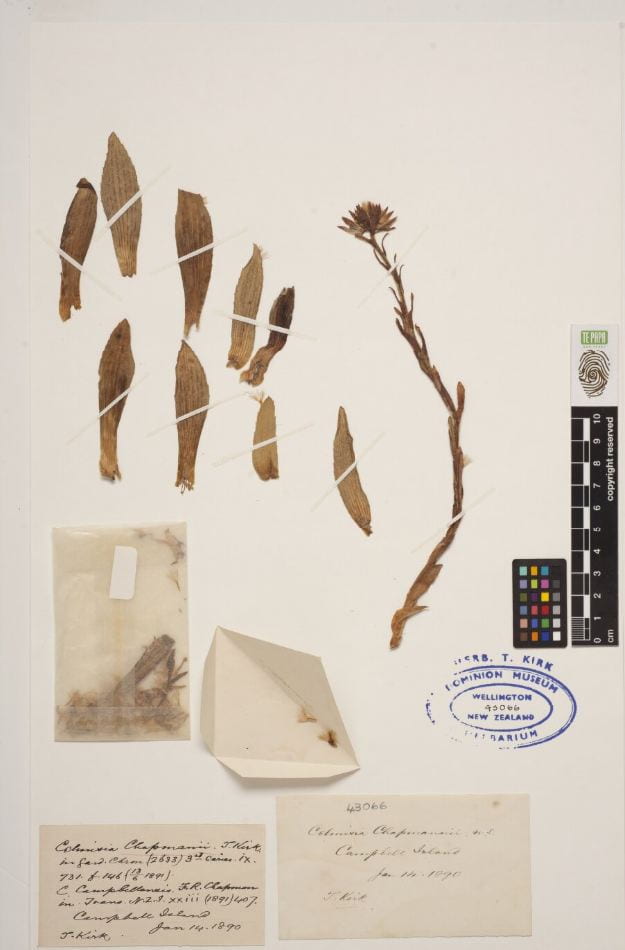
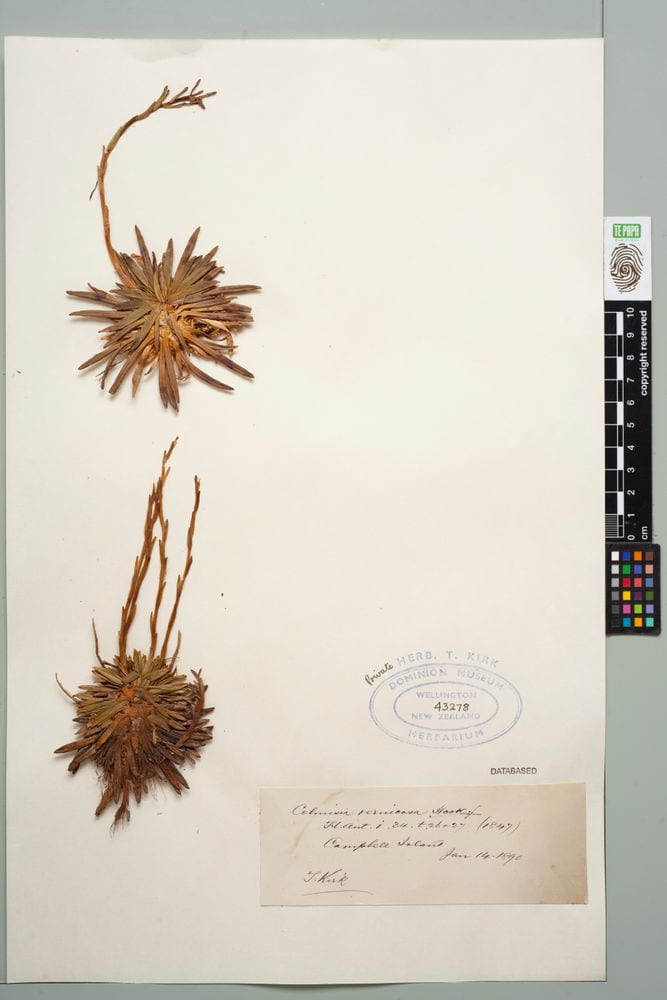
Kirk’s Campbell Island celmisias attracted Emily Harris’s attention and she drew them both, separately and together. Harris descendant Roseanne Cranstone has what may be preliminary studies of both flowers, signed in pencil by Emily:
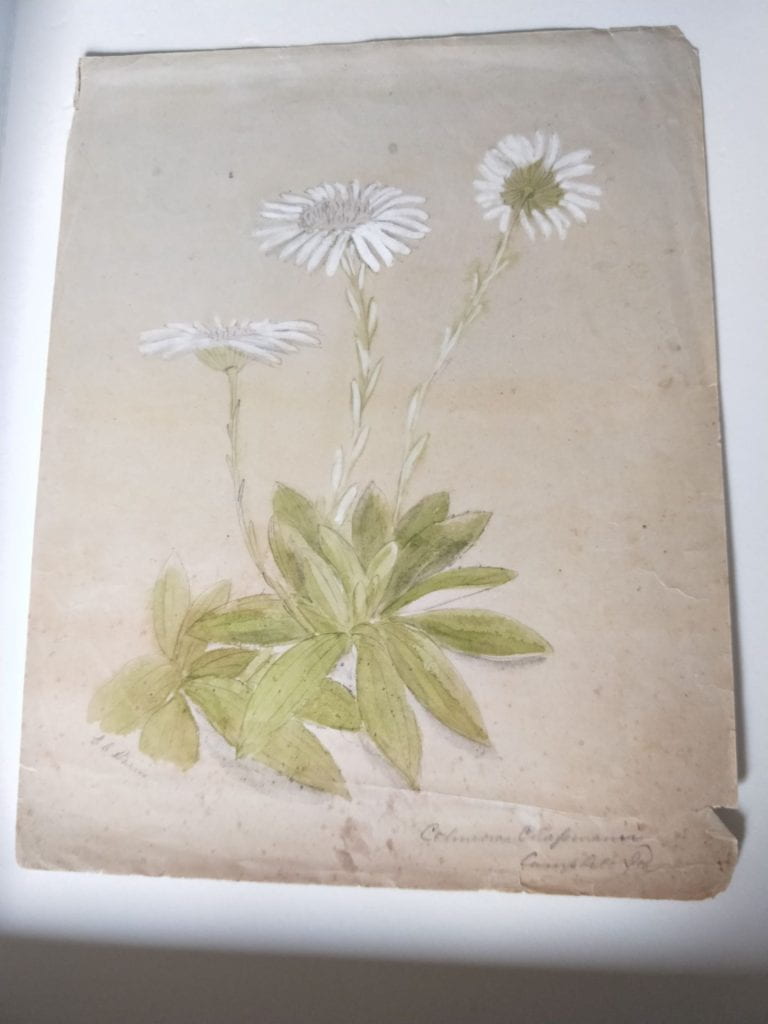
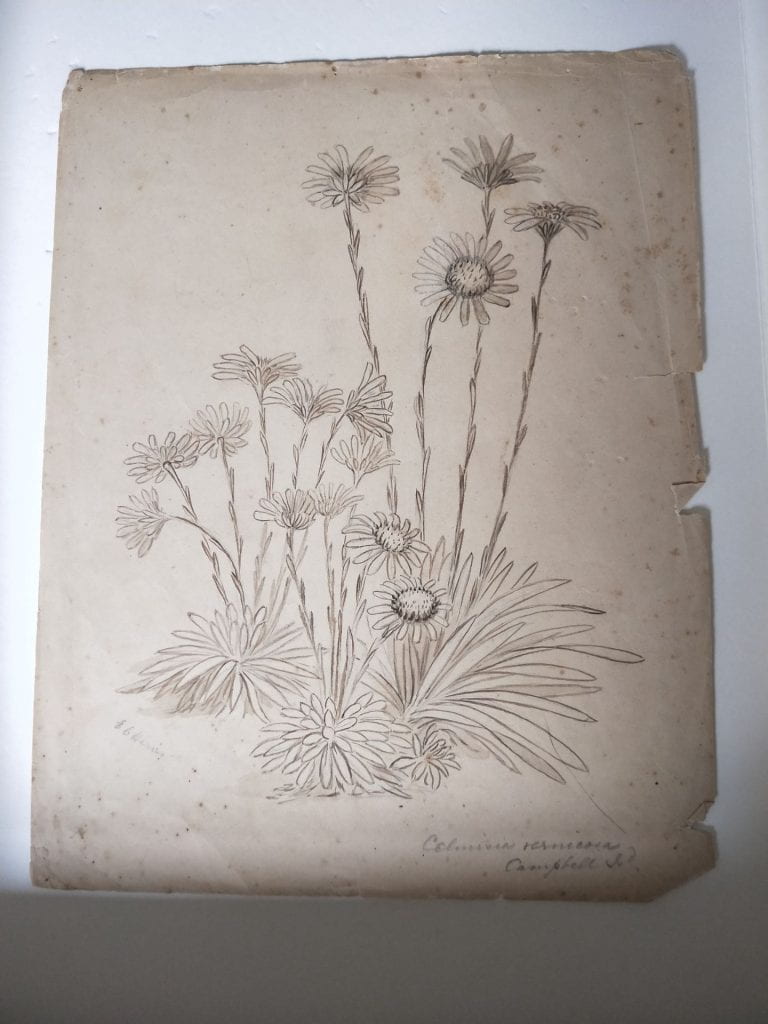
A large landscape-format watercolour depicting both flowers is now at Turnbull. It too styles Celmisia campbellensis as Celmisia chapmanii in acknowledgement of the plant’s discoverer:
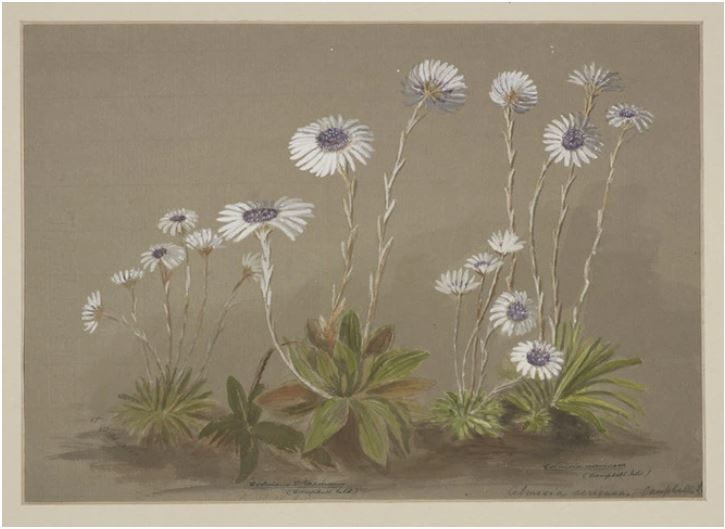
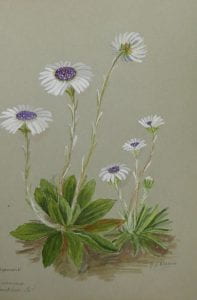
It would seem that Emily wanted to put on international record the celmisias she encountered first at Thomas Kirk’s home in Wellington. That Kirk was also eager to publicise his Campbell Island celmisias becomes evident in two short articles that appeared in the weekly Gardener’s Chronicle in London, 9 May and 13 June 1891. Here again is Celmisia campbellensis identified after its discoverer as Celmisia chapmanii. And here too are engravings that mirror perfectly Emily Harris’s prelimiary sketches of both plants:
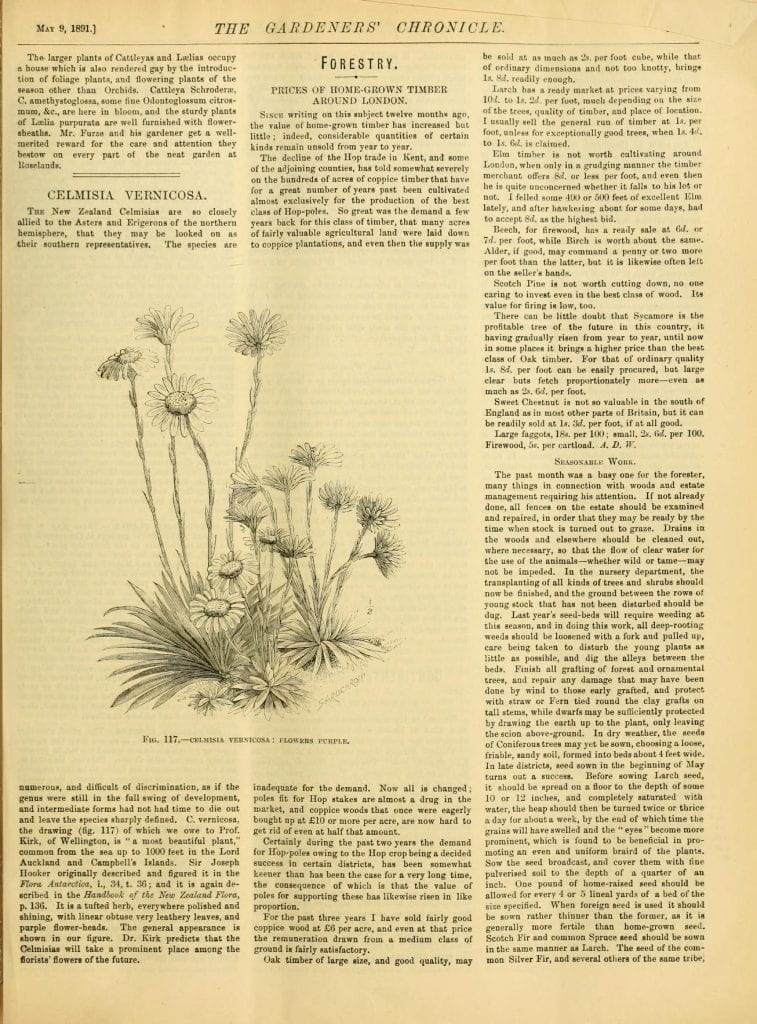
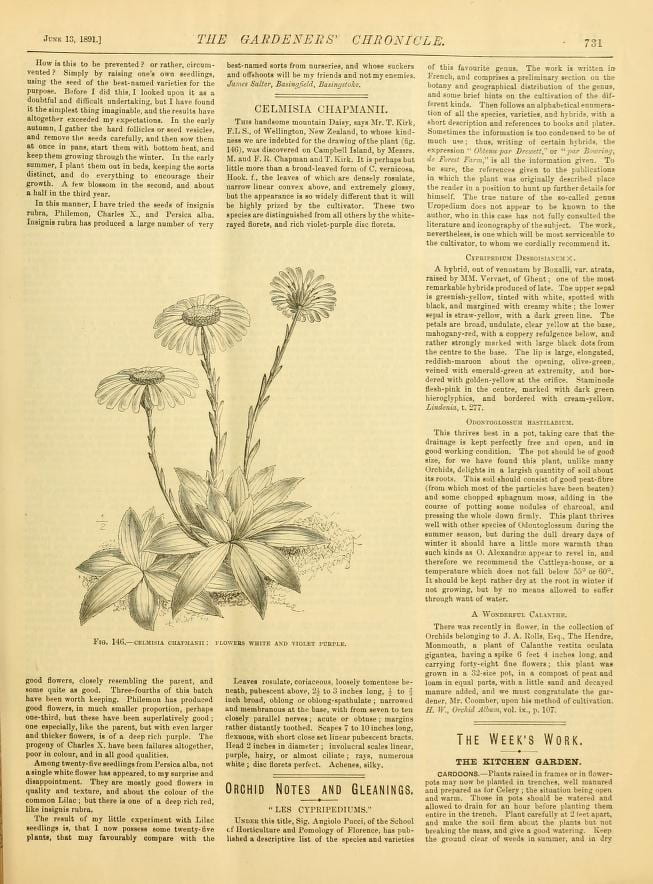
CELMISIA VERNICOSA.
The New Zealand Celmisias are so closely allied to the Asters and Erigerons of the northern hemisphere, that they may be looked on as their southern representatives. The species are numerous, and difficult of discrimination, as if the genus were still in the full swing of development, and intermediate forms had not had time to die out and leave the species sharply defined. C. vernicosa, the drawing (fig. 117) of which we owe to Prof. Kirk, of Wellington, is ” a most beautiful plant,” common from the sea up to 1000 feet in the Lord Auckland and Campbell’s Islands. Sir Joseph Hooker originally described and figured it in the Flora Antarctica, i., 34, t. 36 ; and it is again described in the Handbook of the New Zealand Flora, p. 136. It is a tufted herb, everywhere polished and shining, with linear obtuse very leathery leaves, and purple flower-heads. The general appearance is shown in our figure. Dr. Kirk predicts that the Celmisias will take a prominent place among the florists’ flowers of the future. (Gardener’s Chronicle, Vol IX Jan-June 1891: 587)
CELMISIA CHAPMANII.
This handsome mountain Daisy, says Mr. T. Kirk, F.L S., of Wellington, New Zealand, to whose kindness we are indebted for the drawing of the plant (fig. 146), was discovered on Campbell Island, by Messrs. M. and F. R. Chapman and T. Kirk. It is perhaps but little more than a broad-leaved form of C. vernicosa,Hook, f , the leaves of which are densely rosulate, narrow linear convex above, and extremely glossy, but the appearance is so widely different that it will be highly prized by the cultivator. These two species are distinguished from all others by the white-rayed florets, and rich violet-purple disc florets. (Gardener’s Chronicle, Vol IX Jan-June 1891: 731)
Did Emily Harris supply Thomas Kirk with drawings of the celmisias that he sent to London for engraving as illustrations for the Gardener’s Chronicle? We don’t know, but the identical fit of sketch to engraving seems to point that way, continuing the history of multiple loops between southern hemisphere field work and its record in British repositories. Checking for Celmisia campbellensis / chapmanii in the herbarium at the Royal Botanic Gardens, Kew, we find Frederick Chapman’s type specimen, forwarded by him in 1893 at the request of eminent fellow botanist Donald Petrie:
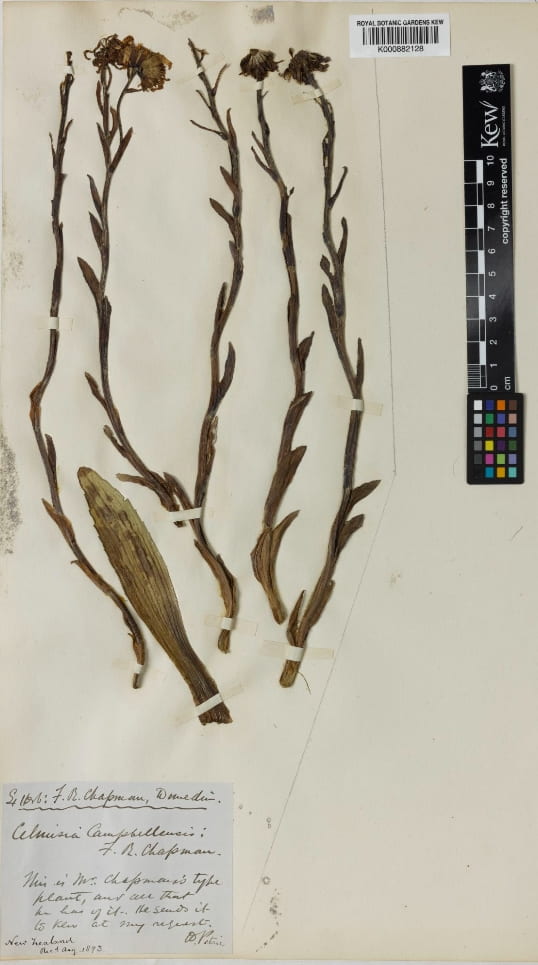
Two months before the publication of the celmisias in the Gardener’s Chronicle Thomas Kirk records two specimens sent to him by Miss Harris of Nelson and now in the Te Papa collection. Purple umbrella sedge, an introduced species, is Emily Harris’s one known appearance in Kirk’s herbarium:
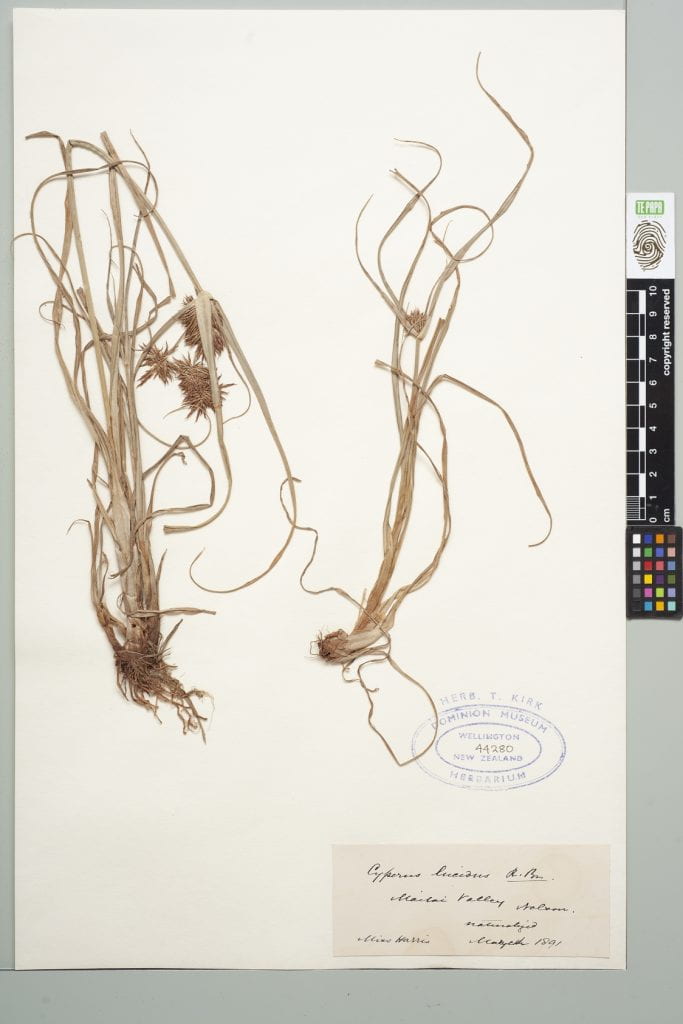
Without doubt Emily sketched the purple-flowered weed from the Maitai Valley before sending two plants to Kirk in Wellington. She is after all an active if largely undetected part of his network of field collectors and correspondents.
Acknowledgements
We are grateful to Bridget Hatton and Dr Heidi Meudt of the Botany Department at the Museum of New Zealand Te Papa Tongareawa for their help with locating herbarium specimens and identification of sub-antarctic flora.